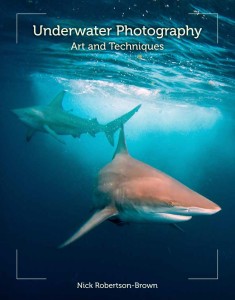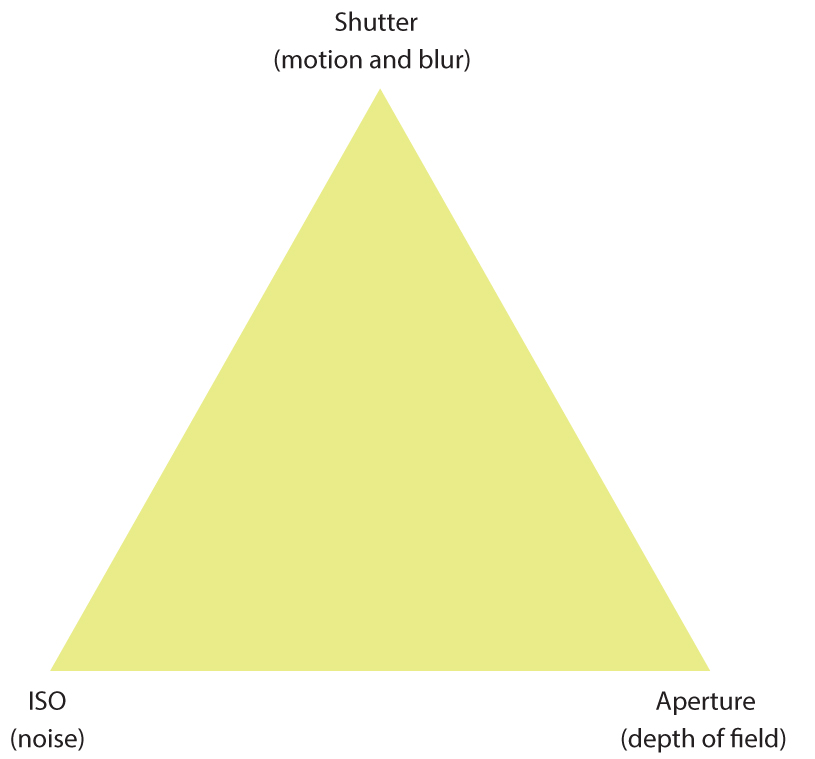News
Underwater Photography Essentials: Part 2

Tips, ideas and advice for budding underwater photographers
by Nick Robertson-Brown FRPS
Part 2: Getting to grips with your camera settings – Shutter Speed
On a digital SLR, the shutter is a mechanical device that blocks the light to the sensor of the camera, but can be opened to allow light onto the sensor when the release button is pressed. Whilst Micro 4/3 and compact cameras may not have a mechanical device for controlling the amount of light that hits the sensor, the action of the shutter is mimicked electronically. Whether it be mechanical or electronic, the speed of the shutter is the second item of the light triangle and the higher the shutter speed, the less time there is for light to get through to the sensor. As stated in part one, the aperture restricts the amount of light entering the camera too, but as discussed, the more light we allow through the aperture, then the smaller the depth of field will be. This leaves us with a trade-off in how we allow the light onto the sensor. If you are photographing moving objects, such as fish, the shutter speed becomes the dominant factor in deciding the level of light. If your shutter speed is not fast enough moving objects may look blurred and out of focus. This is called motion blur and you can use it to great effect if you get it right, as it will give the impression of speed and motion as it moves through the water.
Working within a range of shutter speeds, with and without strobes, in order to freeze fast the moving action and make it pin sharp, use settings of 1/125 to 1/250 (or higher if your camera will synch with the strobes). But remember, as the shutter will not be open for long, not much light will make it onto the sensor. For slow moving subjects, or to achieve some motion blur, work with 1/40 to 1/125 and you will also get more light on your image.
For the cameras that do not have a mechanical shutter, the light is allowed through to the sensor all the time it is switched on. It is, however, only when the release button is pressed that the pixels in the sensor, which are already charged with light, start reading it and then pass the digital image through to the sensor. It is this moment that is recorded by the camera and the balance between the shutter speed and the f-stop will determine how your image looks.
 The shutter speed is also important for defining the background colour of the water, particularly if you are using flash or strobe. In this instance, the flash will freeze the action close to the camera, but as light will only travel a few metres underwater, the light from the background will be presented at the sensor according to the aperture or the shutter speed. This will be covered in greater depth when we get to the part of this series on artificial light, but put simply, the aperture should be set to expose for the subject when the flash fires and the shutter speed can be adjusted, within a small range, so that the background will lighten as you increase the time the shutter is open. Conversely, as you close the shutter, the background colour will become darker. This interplay of aperture and shutter speed will give a light value that will vary in a similar way to how it does in air. It is when you introduce artificial light that the options become greater.
The shutter speed is also important for defining the background colour of the water, particularly if you are using flash or strobe. In this instance, the flash will freeze the action close to the camera, but as light will only travel a few metres underwater, the light from the background will be presented at the sensor according to the aperture or the shutter speed. This will be covered in greater depth when we get to the part of this series on artificial light, but put simply, the aperture should be set to expose for the subject when the flash fires and the shutter speed can be adjusted, within a small range, so that the background will lighten as you increase the time the shutter is open. Conversely, as you close the shutter, the background colour will become darker. This interplay of aperture and shutter speed will give a light value that will vary in a similar way to how it does in air. It is when you introduce artificial light that the options become greater.
For a black background shot, start out with settings similar to f8 (or above), 1/200, ISO 100 and a low strobe power setting and then make changes in the shutter speed and watch the background colour change.
The shutter speed settings on the camera are not merely random numbers that the manufacturer has come up with. When changing the aperture, the f-stop scale is a mathematical constant. Each stop doubles or halves the amount of light getting through to the sensor. The shutter speed is also scaled in this way; each stop (or setting) will double or halve the amount of light getting through to the sensor. This means that if you wish to maintain the same exposure value on your image, if you open the aperture by one stop, you must double the speed of the shutter by one stop.
————————————————————————————————————————————————————
 Do you want to learn more? You can pick up a copy of Nick’s book “Underwater Photography Art & Techniques” by clicking here.
Do you want to learn more? You can pick up a copy of Nick’s book “Underwater Photography Art & Techniques” by clicking here.
Underwater Photography Courses
Contact Nick for information on the Frogfish Photography Complete Underwater Photography Award, designed for 1:1 and small group sessions to improve your underwater photography at your pace.
www.frogfishphotography.com | frogfishphotos@gmail.com | ![]() +44 (0)161 9177101
+44 (0)161 9177101
Gear News
Introducing the TR-80, IR-50 and CS-30 Regulators from DYNAMICNORD

Whether you are a beginner or a professional diver – with the three new main regulators from DYNAMICNORD, everyone will find their favourite regulator. They all look super stylish.
Excellent performance with the TR-80
Quality and performance are the be-all and end-all for regulators. It is not for nothing that the TR stands for Tec Reg. The innovative design of the TR-80 guarantees absolute reliability – even in ice-cold waters.

Perfect breathing effort at 0.8 J/l / certified for diving in waters below 10 degrees / structural design made of solid brass for best cold protection / membrane-compensated design with dry seal of the first stage / reduced exhalation effort thanks to optimized exhalation membrane and bubble deflector / adjustable Venturi (dive/predive) and adjustment knob for individual inhalation comfort / innovative design of the front cover prevents free-flow in strong currents or when diving with scooters / design made of sandblasted brass, matt chrome finish / 2 HP and 4 LP outlets / mouthpiece made of high-quality, anti-allergic silicone for maximum comfort.


Amazing underwater adventures with the IR-50
The IR-50 is the top regulator for advanced and experienced divers. Natural breathing is the essence of this regulator.

Ideal breathing effort at 0.8 J/l /certified for diving in waters below 10 degrees / compensated membrane / adjustable venturi (dive/predive) and adjustment knob for individual inhalation comfort/ outlet valve and deflector for minimum exhalation effort and reduction of bubbles on the face / design made of sandblasted brass, matt chrome finish / 2 HP and 4 NP outlets / mouthpiece made of high-quality, anti-allergic silicone for maximum comfort.


The Workhorse – our CS-30
For diving centres and diving beginners – the workhorse stands for strong construction, reliability and robustness. Perfect for your training.

Optimal breathing effort at 0.8 J/l /recommended for diving in waters above 10 degrees / non-compensated piston / adjustable venturi (dive/predive) / outlet valve and deflector for minimum exhalation effort and reduction of bubbles on the face / design made of sandblasted brass, matt chrome finish / 1 HP and 3 NP outlets / mouthpiece made of high-quality, anti-allergic silicone for maximum comfort.


Octopus OP-30
The OP-30 is the ideal addition to all DYNAMICNORD regulators. It is identical in construction to the CS-30.

The TR-80, IR-50, CS-30 (DIN & INT) regulators and the Octopus OP-30 are available from DYNAMICNORD dealers and in the online store.
DYNAMICNORD – Your Outdoor Companion.
Marine Life & Conservation
Paul Watson Released as Denmark Blocks Japan’s Extradition Bid

Renowned anti-whaling activist Paul Watson has been released from custody in Greenland after spending five months in detention. Denmark’s Justice Ministry rejected Japan’s request for his extradition, citing insufficient guarantees that his time already served in custody would be credited against any potential sentence.
The 74-year-old Canadian-American was arrested on July 21 in Nuuk, Greenland’s capital, when his ship docked to refuel. His arrest was based on a 2012 Japanese warrant related to a 2010 encounter in Antarctic waters. Japan alleged Watson obstructed operations and caused damage to a whaling research ship during efforts to disrupt illegal whaling. Watson has consistently denied these claims, maintaining his commitment to marine conservation.
Denmark, which oversees extradition matters for Greenland, concluded that while the legal conditions for extradition were met, the lack of assurances from Japan regarding time-served credit made extradition untenable.
In a video shared by his foundation, Watson expressed gratitude and relief, saying, “After five months, it’s good to be out… and good to know they’re not sending me to Japan.” He added that the most difficult part of his time in custody was being separated from his two young sons.
Watson is a pioneering figure in marine conservation, known for founding the Captain Paul Watson Foundation in 2022 after decades of activism with the Sea Shepherd Conservation Society. His bold efforts to defend marine life have earned him widespread support, including from celebrities and conservationists. His work has also been featured in the acclaimed reality TV series Whale Wars.
Watson’s lawyer, Jonas Christoffersen, praised the decision, stating, “We are happy and relieved that Paul Watson is now free.” He added that Watson is eager to reunite with his family and continue his vital work.
The arrest occurred while Watson’s vessel, the M/Y John Paul DeJoria, was en route to the North Pacific with a team of 26 volunteers to intercept a Japanese whaling ship. His foundation described the arrest as politically motivated and emphasized that Watson’s actions were focused on ending illegal whaling practices.
Japan resumed commercial whaling in 2019 after leaving the International Whaling Commission, asserting that whale meat is a cultural tradition. Conservationists, however, continue to challenge these practices, highlighting their impact on marine ecosystems.
Despite the challenges, Watson remains steadfast in his mission to protect marine life and bring attention to whaling practices. His dedication to ocean conservation has made him a globally respected advocate for the environment.
-

 News2 months ago
News2 months agoIconic SS United States to become the World’s Largest Artificial Reef
-

 News3 months ago
News3 months agoBook Review – 52 Assignments: Underwater Photography
-

 Gear News3 months ago
Gear News3 months agoDYNAMICNORD – New German diving brand enters the British market
-

 News3 months ago
News3 months agoExploring Cenote El Pit: A Diver’s Dream
-

 Gear News3 months ago
Gear News3 months agoTry BARE drysuits (and maybe even win one!) this Friday with Sea & Sea at North West Dive Fest
-

 Marine Life & Conservation3 months ago
Marine Life & Conservation3 months agoBook Review: Coral Triangle Cameos
-

 Blogs2 months ago
Blogs2 months agoDive the Egyptian Red Sea this Autumn with Regaldive
-

 News3 months ago
News3 months ago2024 Ocean Art Underwater Photo Competition Announced

















